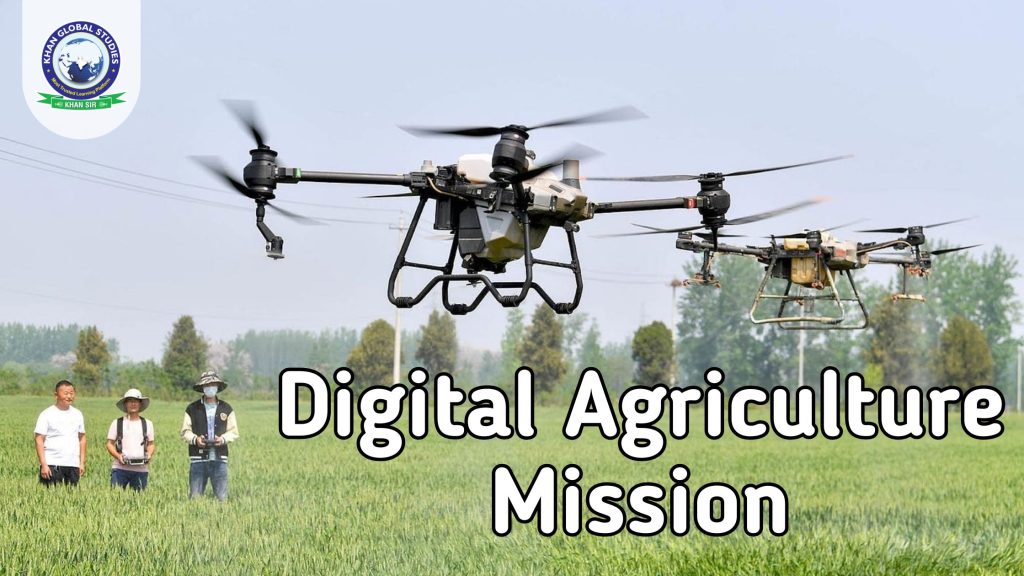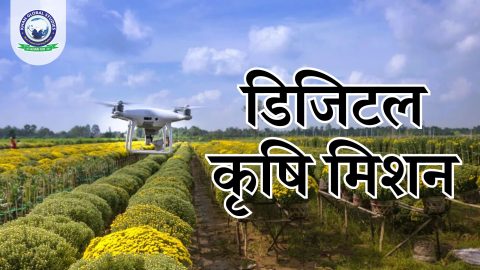The Digital Agriculture Mission (DAM) is a comprehensive initiative designed to improve the lives of farmers through the use of advanced technology. It operates under the framework of Digital Public Infrastructure (DPI) and is in line with the announcements of the Union Budgets for 2023-24 and 2024-25, which emphasize the importance of integrating DPI in agriculture. The mission aims to enhance agricultural decision-making and streamline service delivery to farmers.
Key Features of Digital Agriculture Mission
DAM is built on two key pillars:
1. Agri Stack (Kisan Ki Pehchan)
Farmer-centric digital infrastructure that simplifies access to services and government schemes. It consists of three main components:
- Farmer Registry: A database that provides ‘Kisan ID’, managed by state governments and union territories, which offers farmers a trusted digital identity similar to Aadhaar.
- Geo-referenced Village Map: Links farmer ID to essential data such as land records, demographic information and family details.
- Crop Sown Registry: Tracks crops sown each season through a mobile-based digital crop survey.
2. Agriculture Decision Support System (DSS)
A geospatial platform that links crop, soil, weather and water data to improve agricultural decision-making. It includes:
- Soil Profile Mapping: Detailed maps of soil profile for about 142 million hectares of agricultural land.
- Digital General Crop Estimate Survey (DGCES): Provides yield estimates using scientific methods such as crop-cutting experiments.
3. Mission Target
- Digital IDs for 11 crore farmers within three years (6 crore in 2024-25, 3 crore in 2025-26 and 2 crore in 2026-27).
- Nationwide digital crop surveys will be rolled out in two years, covering 400 districts in 2024-25 and all districts by 2025-26.
Understanding Digital Agriculture
Digital agriculture refers to managing agricultural activities scientifically and efficiently using modern technologies. By implementing precision agriculture and smart farming techniques, farmers can optimize resources and decision-making through data-driven approaches. This includes using big data analysis and web-based platforms to increase farm productivity.
Examples of Digital Technologies in Agriculture
- Drone technology: In 2019, drones were used for locust control in India, spraying pesticides to reduce crop losses.
- Grain Bank Model by Argos: This initiative provides small and marginal farmers access to post-harvest supply chain solutions directly at their doorsteps.
- Yuktix Greensense: A remote monitoring and analysis tool that helps manage disease, pest, and irrigation challenges.
Importance of Digital Agriculture Mission
The mission provides farmers with real-time information to make better decisions, especially in areas such as crop diversification and irrigation planning. The mission ensures transparency and efficiency in agricultural production by providing accurate data on crop areas and yields. This data will also improve the implementation of government schemes such as crop insurance and loan disbursement.
Additional Benefits include:
- Reducing farm losses and boosting farmers’ income through better disaster response and insurance claims.
- Creating employment opportunities for about 2.5 lakh local youth and Krishi Sakhis.
- Improve service delivery by providing farmers easy access to credit, government schemes and advisory services using technology such as AI, remote sensing and data analytics.
Challenges in implementing Digital Agriculture
Despite its promise, digital agriculture faces several hurdles:
- Smallholdings: With an average farm size of 1.08 hectares, implementing digital technologies designed for large farms can be challenging.
- High initial costs: The cost of advanced computing and storage required for digital agriculture is very high, making scalability difficult.
- Inadequate research: There is a lack of detailed studies on how digital technology impacts Indian farming and its profitability.
- Inadequate infrastructure: Rural areas often lack the necessary digital infrastructure, such as internet connectivity, which hinders widespread adoption.
- Low digital literacy: Many farmers are unfamiliar with new digital systems, which reduces trust and makes maintenance and problem resolution difficult.
- Language barriers: Technology interfaces are not always available in local languages, limiting access for many farmers.
Initiatives to Promote Digital Agriculture
Several initiatives have been taken to support the development of digital agriculture:
- India Digital Agriculture Ecosystem (IDEA): Aims to create an integrated database of farmers to promote innovative solutions in agriculture.
- National e-Governance Plan in Agriculture (NeGP-A): Provides farmers free access to relevant agricultural information.
- Market-based interventions: Programmes such as e-NAM and Agmarknet help farmers access better market information.
- Drones for land mapping: Used in the Swamitva Yojana and other smart agriculture programmes.
- National Strategy on AI: Agriculture has been prioritised as a key sector for AI integration.
- Farmer-friendly Apps: Tools such as the PM-KISAN mobile app, Kisan Suvidha app and HORTNET project for horticulture development.
Conclusion
To make the Digital Agriculture Mission a success, it is important to focus on affordability, ease of access, system maintenance and timely grievance redressal. There is also a need for robust research and development along with supportive policies. The mission has the potential to transform Indian agriculture, making it more sustainable, efficient and profitable for farmers as well as improving their overall livelihoods.





